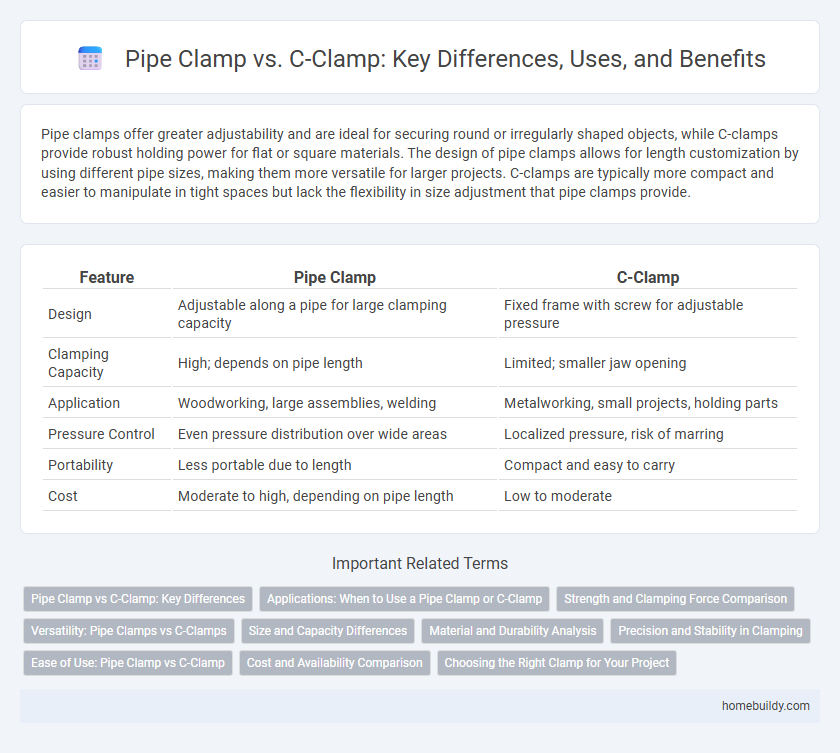Pipe clamps offer greater adjustability and are ideal for securing round or irregularly shaped objects, while C-clamps provide robust holding power for flat or square materials. The design of pipe clamps allows for length customization by using different pipe sizes, making them more versatile for larger projects. C-clamps are typically more compact and easier to manipulate in tight spaces but lack the flexibility in size adjustment that pipe clamps provide.
Table of Comparison
| Feature | Pipe Clamp | C-Clamp |
|---|---|---|
| Design | Adjustable along a pipe for large clamping capacity | Fixed frame with screw for adjustable pressure |
| Clamping Capacity | High; depends on pipe length | Limited; smaller jaw opening |
| Application | Woodworking, large assemblies, welding | Metalworking, small projects, holding parts |
| Pressure Control | Even pressure distribution over wide areas | Localized pressure, risk of marring |
| Portability | Less portable due to length | Compact and easy to carry |
| Cost | Moderate to high, depending on pipe length | Low to moderate |
Pipe Clamp vs C-Clamp: Key Differences
Pipe clamps offer adjustable clamping capacity using a length of pipe, making them ideal for larger woodworking and plumbing projects, while C-clamps provide fixed opening sizes suitable for smaller, precise tasks. The primary difference lies in versatility and size; pipe clamps can accommodate longer workpieces due to their extendable design, whereas C-clamps deliver strong, stable pressure in compact spaces. Materials and application also vary, with pipe clamps frequently used in heavy-duty construction, and C-clamps favored for metalworking and light assembly.
Applications: When to Use a Pipe Clamp or C-Clamp
Pipe clamps are ideal for woodworking and plumbing projects where large, round objects require secure holding, providing adjustable length for varying pipe sizes. C-clamps offer strong, precise clamping for metalworking, welding, or smaller-scale tasks needing high-pressure grip on flat or irregular shapes. Choose pipe clamps for extended clamping surfaces and flexible adjustments, while c-clamps excel in tasks requiring compact, rigid clamping force.
Strength and Clamping Force Comparison
Pipe clamps provide superior clamping force for round objects due to their adjustable design that distributes pressure evenly around the pipe's circumference. C-clamps, while versatile, typically deliver less uniform pressure and lower overall strength, making them less effective for securing cylindrical materials. The structural design of pipe clamps allows higher torque application, resulting in stronger, more stable clamping compared to the limited arm leverage of C-clamps.
Versatility: Pipe Clamps vs C-Clamps
Pipe clamps offer superior versatility compared to C-clamps, as their adjustable length accommodates a wider range of pipe diameters and project sizes. The sliding mechanism on pipe clamps enables users to quickly modify the jaw opening, making them ideal for woodworking and metalworking tasks requiring variable clamping dimensions. C-clamps provide sturdy, localized pressure but lack the adaptability of pipe clamps in handling diverse clamping scenarios.
Size and Capacity Differences
Pipe clamps are specifically designed to accommodate the diameter variations of pipes, offering greater size flexibility compared to c-clamps. While pipe clamps adjust easily along the length of the pipe for extended reach and larger clamping capacity, c-clamps have a fixed throat depth and limited jaw opening that restrict size adaptability. The pipe clamp's design enables securing larger or irregularly sized objects, making it ideal for plumbing and construction tasks requiring versatile clamping sizes and capacities.
Material and Durability Analysis
Pipe clamps typically feature robust steel or cast iron construction designed to withstand high pressure and heavy loads, offering superior durability in plumbing and industrial applications. C-clamps are often made from lighter materials like aluminum or mild steel, which provide adequate strength for woodworking and light metalwork but may wear faster under heavy or prolonged stress. The material composition of pipe clamps ensures enhanced resistance to corrosion and deformation compared to the generally less rugged c-clamps.
Precision and Stability in Clamping
Pipe clamps provide enhanced precision and stability compared to C-clamps due to their adjustable sliding mechanism that allows for uniform pressure distribution along the pipe's length. The pipe clamp's design minimizes movement and maintains consistent alignment, which is critical for woodworking and metal fabrication tasks requiring accurate joint assembly. In contrast, C-clamps can create uneven pressure points and limited clamping range, making pipe clamps the preferred choice for applications demanding stable and precise clamping.
Ease of Use: Pipe Clamp vs C-Clamp
Pipe clamps offer greater ease of use compared to C-clamps due to their adjustable length and quick-release mechanism, enabling faster and more flexible pipe securing. The lightweight design and ergonomic handle of pipe clamps reduce user fatigue during repetitive clamping tasks. In contrast, C-clamps require manual tightening and repositioning, which can be time-consuming and less efficient for larger or variable pipe diameters.
Cost and Availability Comparison
Pipe clamps generally offer a more cost-effective solution compared to C-clamps due to their specialized design for securing pipes with minimal risk of damage. They are widely available in hardware stores and online retailers, often in various sizes tailored to different pipe diameters, enhancing accessibility. In contrast, C-clamps, though also common, tend to have a higher price point for comparable sizes and are less specialized, which may limit their practicality and availability for pipe-focused projects.
Choosing the Right Clamp for Your Project
Pipe clamps provide adjustable support for larger, round objects and are ideal when working with pipes or cylindrical materials, offering versatility in length and strength. C-clamps, with their fixed frame and versatile jaw opening, excel at applying strong, localized pressure on smaller, flat, or irregular surfaces. Selecting the right clamp depends on the project's material shape and size, with pipe clamps favored for round objects and c-clamps preferred for precision and firmness on flat or uneven surfaces.
pipe clamp vs c-clamp Infographic

 homebuildy.com
homebuildy.com